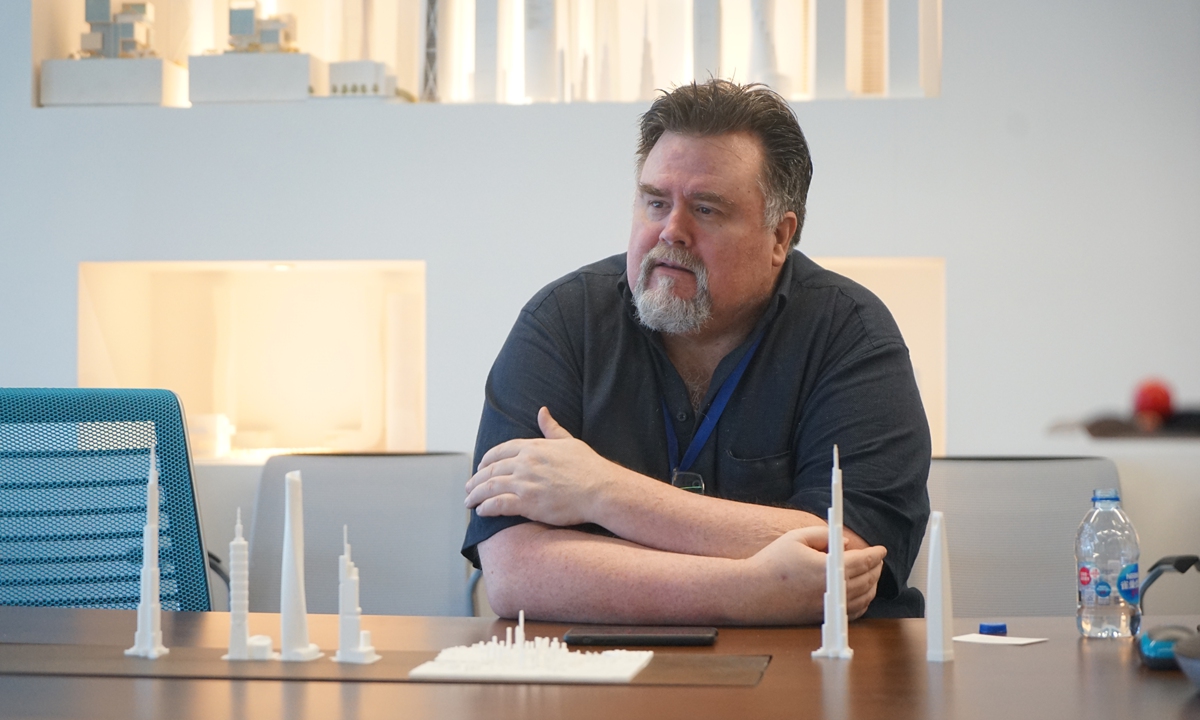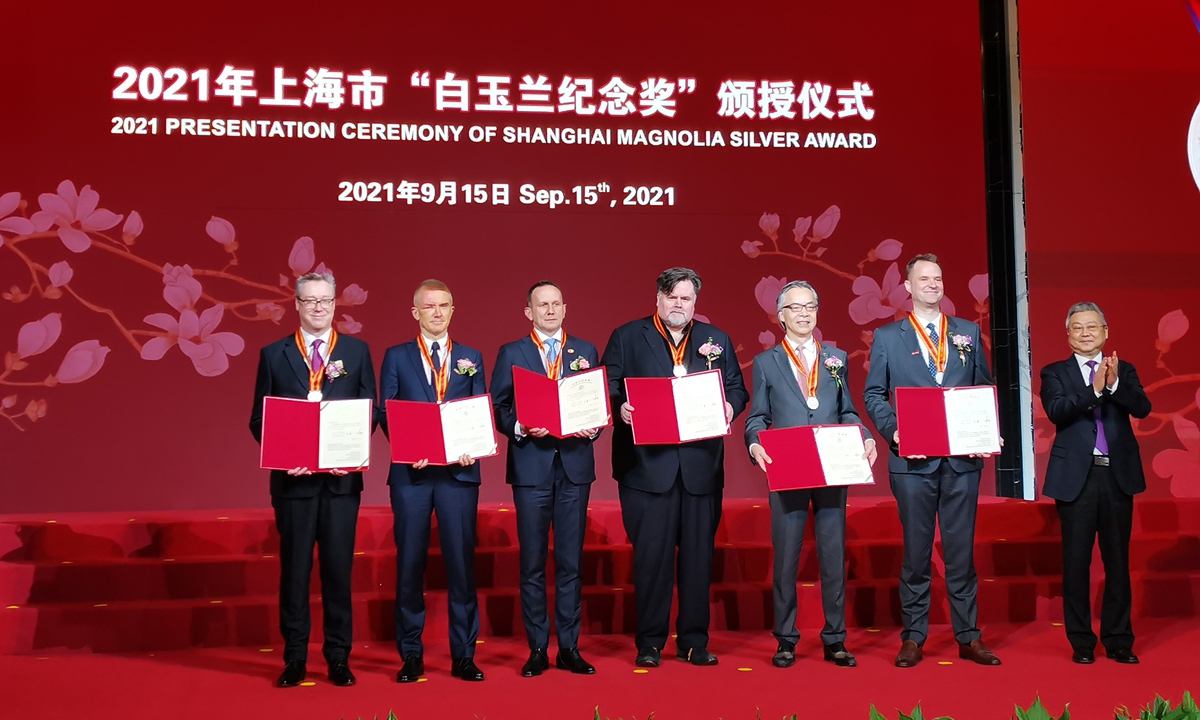Editor's Note:
China's modernization has been an epic journey over the last decade. Under the leadership of the Communist Party of China (CPC), China has become an attractive destination for many foreigners. Many such expats in the country have fulfilled their career aspirations, while some have found love and started families in China.
Why do they choose to live in China? How do expats in China view and interpret China's achievements and persistence measured from various perspectives? The Global Times interviewed multiple international residents in China from all walks of life, some of whom have made tangible contributions to China's development, to learn about their understanding of the essence of Chinese culture, and gain an insight into how far China has advanced in its pursuit of development and rejuvenation over the last decade.

Marshall Strabala at his office which is located in the Shanghai Tower Photo: Chen Xia/GT
Marshall Strabala (left 4th) at the Shanghai Magnolia Silver Award ceremony in September 2021 Photo: Courtesy of Marshall Strabala
On a sweltering early Tuesday morning, Marshall Strabala walks across the street, and heads straight into the 632-meter-high Shanghai Tower, China's tallest building, of which Strabala is the chief architect.
Strabala's own design office is located right in the famed building, which is adjacent to the neighboring Jinmao Tower and the Shanghai World Financial Center (WFC), in the heart of the Lujiazui Finance and Trade Zone in Shanghai's Pudong New Area, representing the Shanghai skyline's most prominent architectural fixtures.
"My greatest achievement is the design and construction of the Shanghai Tower. I am so proud of the building and what it represents," Strabala, currently a founding partner at Strabala Architecture, said. "I love coming to work in a building I designed, and it makes me feel accomplished."
Strabala was honored with the Shanghai Magnolia Silver Award in 2021 as a foreigner who has made outstanding contributions to the metropolis.
'American architect, but made in China'
Having been an architect for over 33 years, 61-year-old Strabala is responsible for more than 50 million square meters worth of projects around the world. As a licensed architect from the US, "as my partner Edward Jiang says, I'm an American architect, but made in China," Strabala said with a smile.
After receiving a Master in Architecture from Harvard University, Strabala started his career working for a small firm in Cambridge, Massachusetts. After graduating, he then joined SOM Chicago, a very large architectural company in the US, and led the design team in working on projects thereafter like the Burj Khalifa in Dubai, Zifeng Tower in East China's Nanjing, and the Hong Kong Convention and Exhibition Centre.
Strabala's first trip to Shanghai was in 2000 when he worked for SOM. He then started to work in Gensler in March 2006, and two months later, he was dispatched to Shanghai for work for several months.
During the same period, Shanghai's Pudong New Area, which has always been at the frontier of China's reform and opening-up, sped up its development. In June 2005, the State Council, China's cabinet, approved Pudong's role as the first pilot region for comprehensive reforms, according to the authorities.
From August to September 2006, and February to April 2008, Strabala and his colleagues in Gansler participated in the first and the second competition, respectively, for the design and construction of the Shanghai Tower thanks to his expertise in super tall buildings. They finally won the contract in June 2008, and Strabela started to live and work in China full-time.
"My trips back to the US got shorter and shorter, and my time in China got longer and longer," Strabala said.

Past, present, and future
In Strabala's eyes, the three most iconic super tall buildings - the Jinmao Tower, the Shanghai WFC, and the Shanghai Tower - represent China's past, present, and future.
The image of a city is "a very odd thing," and the first thing is it can't be a copy of another city. If you choose to create something original, your city has a "unique presence" because the image of New York and the image of Shanghai are two different things. But if they look the same, it would be a terrible thing, said Strabala. "All of the buildings, not just the tall ones, in Shanghai actually create the skyline."
"When I was designing this building, what I wanted to do was to have a very thoughtful green skyscraper. The idea was to make the world's greenest skyscraper," Strabala said.
"In the two competitions, we chose a 120-degree rotation, which was an educated guess." The final rotation amount was studied "in both a wind tunnel and from an aesthetic point of view … The more twist improved the performance, but made the building look odd, so the team settled on a total 137-degree rotation. This was the best looking and best performing," Strabala said.
Strabala came up with the idea of the past, present, and future because, to him, the Jinmao Tower looks to the past of Chinese construction in form of a stainless steel pagoda, while the WFC represents foreign investment flowing into China, and the Shanghai Tower represents the future of China.
The twist of the Shanghai Tower is something that's very "unique" to the image of the building, and also aids in saving money and in making the building greener. "There's been no other building like it in the world," Strabala said.
The idea of the three above-mentioned buildings metaphorically ties Shanghai - a metropolis with more than 25 million residents - together, as witnesses to the city's rapid development in the last decade.
Over the last decade, Shanghai's GDP doubled from 2.13 trillion yuan ($314.68 billion) in 2012 to 4.32 trillion yuan in 2021, ranking fourth among cities in the world while the city's total trading volume in the financial markets increased from 528 trillion yuan to 2,511 trillion yuan.
Unprecedented development
As a foreign architect living in China, Strabala said he has seen "unprecedented" development in the last few years in China.
"The amount of building in China over the last 20 years has never been done on this planet. We saw the growth of cities like New York and Chicago, but that was over hundreds of years. China has done it in 20 [years] to a level that no one else has ever done before," Strabala said.
Strabala said that not only has architectural development been seen in first-tier cities, but third-tier cities such as Wuxi also have some magnificent buildings which are clean and elegant. This has also continued to inspire Strabala's work in China as they look for unusual projects, which could either be super tall buildings, master plans, or small projects.
Even during Shanghai's two-month lockdown due to a COVID-19 outbreak, Strabala's company won a new Jiao Tong University campus project in the city's Chongming island, which will be the world's largest carbon-neutral building and a new model for sustainable design in China.
China has also been seeking ways to make buildings in the country safer and greener in recent years.
In cities with a permanent population of more than 3 million, the construction of new super tall buildings of more than 250 meters shall be strictly restricted, and no new super-tall buildings of more than 500 meters shall be built, according to China's housing and urban-rural development authorities in October 2021.
"When I first heard this, I was quite shocked, not because I disagree with it, but because I agree with it, and it was a very wise thing to do," Strabala said. Having had a lot of experience in super tall building design and construction, Strabala knows tall buildings cost a lot more money to complete.
And as a Shanghai resident for several years, Strabala and his wife quite enjoy their life in Shanghai. He also loves learning Chinese calligraphy and knows about 300 characters, but he said that it is still hard for him to speak the language.

